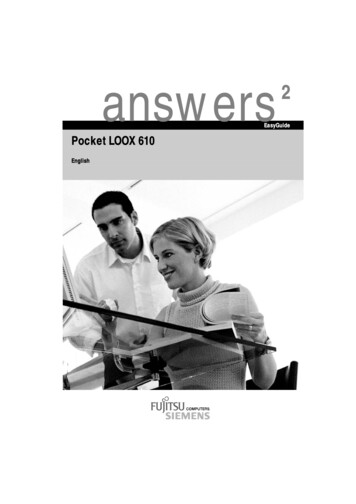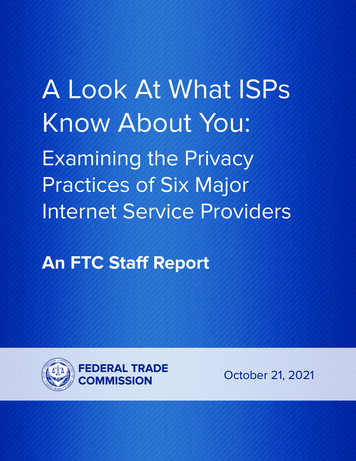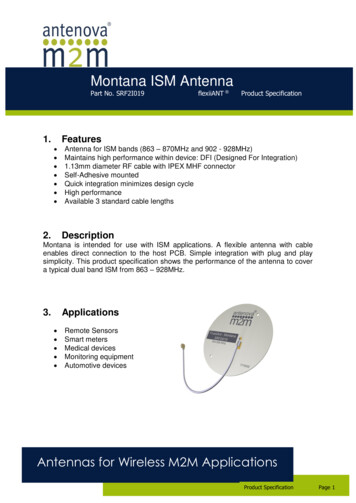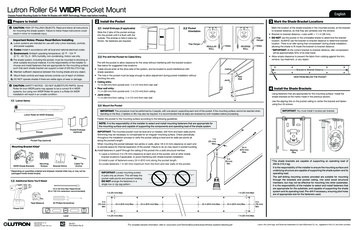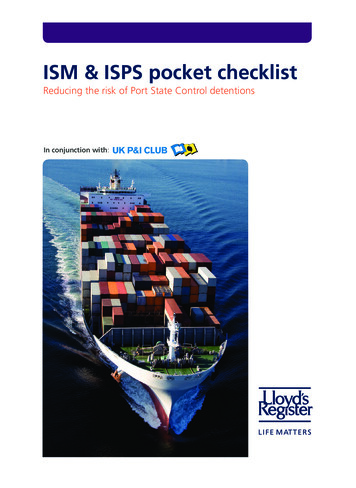
Transcription
ISM & ISPS pocket checklistReducing the risk of Port State Control detentionsIn conjunction with:PSC pocket guide.indd 117/08/10 11:58
IntroductionPort State Control detentions due to ISM failures are becoming more commonas the authorities are grouping deficiencies together to justify detaining the ship.The objectives of the International Safety Management (ISM) Code are to ensuresafety at sea, prevention of human injury or loss of life, and avoidance of damageto the environment and property. The objectives of the ISPS Code are to ensuresecurity of ships and port facilities. The company is responsible for implementingan effective safety and security management system to ensure these objectives aremet. By doing this, the risk to the fleet can be minimised and avoid costly fines andPort State Control detentions. Effective implementation of ISM and ISPS will protectthe fleet’s reputation and help to get most out of the company’s resources.In conjunction with an industry partner, the UK P&I Club, we have analysed dataincluding deficiencies found by Port State Control Officers relating to ISM &ISPS. The result is this convenient and re-usable Checklist, highlighting the mostcommon deficiencies.To help reduce these risks, as a minimum, the items on the chart on page4 should be included as part of your final checks prior to voyage and portentry to ensure they continue to conform to international conventionrequirements. It is strongly advised that all items in this aide memoire arechecked on an ongoing basis to supplement your own operational andmaintenance procedures and your flag State’s requirements.This is the fifth in a series of pocket checklists to help you comply with internationalconvention requirements. For information about other checklists in this seriesplease visit www.webstore.lr.org or www.ukpandi.comLloyd’s Register, its affiliates and subsidiaries and their respective officers, employees or agentsare, individually and collectively, referred to in this clause as the ‘Lloyd’s Register Group’. TheLloyd’s Register Group assumes no responsibility and shall not be liable to any person for anyloss, damage or expense caused by reliance on the information or advice in this document orhowsoever provided, unless that person has signed a contract with the relevant Lloyd’s RegisterGroup entity for the provision of this information or advice and in that case any responsibility orliability is exclusively on the terms and conditions set out in that contract.ISM & ISPS Lloyd’s Register / UK P&I Club, 2010PSC pocket guide.indd 2Page 217/08/10 11:58
Are you prepared for a Port State ControlInspection?PSC officers always commence their inspection in the Master’s office. It is essentialthat certification is up to date, original and valid. All other necessary documentsand manuals should, where required, be approved and onboard.If equipment is broken or missing, or the ship has suffered damage en-route, theMaster must notify the port authorities prior to port entry. If the port authorities areinformed of the problem and of any permanent or temporary remedies agreed withthe flag State, the vessel should not be detained. However, if notice is not givenbefore entry, the Port State has clear grounds for inspection, possibly leading to adetention.If your ship is detained, or appears to be in the process of being detained,you should contact the nearest Lloyd’s Register Group office immediatelyfor assistance.The major PSC organisations publish their criteria for targeting a ship on their websites. Ship owners and operators should use these criteria to calculate the targetrating of their ships.Paris MOU - www.parismou.orgTokyo MOU - www.tokyo-mou.orgUSCG - er MOUs include Abuja, Black Sea, Caribbean, Indian Ocean,Mediterranean, Riyadh and Vina del Mar.A ship operator may disagree with the findings of the PSC Authority and themajority of the regional PSC organisations have guidelines on how to appealagainst a detention. These can also be found on the above web sites.IMO Procedures for Port State Control, Appendix 1 also provides guidelineson detentions [ISBN: 92-801-5099-5].ISM & ISPS Lloyd’s Register / UK P&I Club, 2010PSC pocket guide.indd 3Page 317/08/10 11:58
ISM & ISPS deficienciesThe following are the most common ISM/ISPS deficiencies (by number) found by Port StateControl officers during the period 2007-2009 on ships classed by Lloyd’s Register.422327475230656586485692550 Maintenance of the ship and equipment (306)2540 Emergency preparedness (85)0162 Continuous synopsis record (69)2545 Reports and analysis of non-conformities, Reports and accidents and hazardous occurences (64)2705 Security Related Deficiencies (58)2535 Development of plans for shipboard operations (56)2530 Resources and personnel (52)2555 Documentation (47)2515 Company responsibility and authority (42)2510 Safety and environmental policy (27)2525 Master’s responsibility and authority (23)ISM & ISPS Lloyd’s Register / UK P&I Club, 2010PSC pocket guide.indd 4Page 417/08/10 11:58
1. First ImpressionThe first impression the Port State Authority gain is very important. It will setthe scene for any inspections that take place. Take note of:1.Gangway & moorings- in good condition- rigged as required (e.g. wires, steps, gangway net, bottomstanchions, man ropes)- clean (e.g. no grease from fall wires on steps, handrails, manropes)2.Access control- identification check (check for photo ID)- visitors log maintained- restricted areas controlled3.Appearance of gangway watch, officers and crew- neat working clothes- appropriate personal protective equipment- professional attitudeRigged gangway4.Appearance of accommodation and outside decks- clean- tidy- well illuminated- non slip walkways on outside deck5.PSC officer should be accompanied by senior officer(s) duringinspection, tour of the vessel etc.- the accompanying officer(s) should have keys readily available toaccess secured areas and lockersISM & ISPS Lloyd’s Register / UK P&I Club, 2010PSC pocket guide.indd 5Page 517/08/10 11:58
2. Certificates and DocumentsCertificates and documents must be valid, carried onboard and available for review.Certificates:1.All required classification, statutory and other trading certificatesare readily available2.A copy of the company’s document of compliance (DoC) with theendorsements for annual verifications3.Safety Management Certificate (SMC)4.International Ships Security Certificate (ISSC)5.The latest issue of the Continuous Synopsis Record (CSR) isavailable and valid (see also Note 1). The file of previously issuedCSR’s is completeNotes:1. The name, Company ID number and address of the Company and ship typemust be the same on SMC, DoC, ISSC and CSR.2. Reference to required certification and documentation can be found in MSC/Circular.1151 (as amended or superseded).ISM & ISPS Lloyd’s Register / UK P&I Club, 2010PSC pocket guide.indd 6Page 617/08/10 11:58
2. Certificates and Documents - continuedDocuments:6.All ISM manuals, procedures and instructions are available in thelatest revisions7.A copy of the company’s Safety and Environmental policy isavailable8.All records required by the ISM procedures are available andcompleted as required9.Ship’s library, documentation and manuals are valid, complete andavailable as applicable and as required by the procedures and Flag10.The approved Ship Security Plan (SSP) is available, includingevidence of the approval (Approval Letter and Report)Notes:1. The relevant procedures, instructions and records must be in the workinglanguage or languages understood by all personnel.2. Evidence that the SSP has been submitted for approval may be acceptable inspecial circumstances.3. All officers and crew should have access to the relevant procedures andinstructions, including the Life Saving Appliances and Fire Safety trainingmanuals that should be available in the officers and crew lounges.4. It is recommended that notice boards are kept up to date to highlight safetybulletins, procedural changes, contact details, work and rest hours and otherrelevant information.ISM & ISPS Lloyd’s Register / UK P&I Club, 2010PSC pocket guide.indd 7Page 717/08/10 11:58
3. System ManagementThe effectiveness of the Safety Management System is to be analysed andreviewed. Opportunities for improvement of the system are to be identified andimplemented. The following are some of the key aspects to achieve this:1.The Master’s Reviews are carried out as required and relevantidentified action items are addressed2.Internal audits are held as required by the Management System,at intervals not exceeding twelve months. Reports are to be madeavailable on board3.External audits are held as required by the ISM Code, reports areavailable on Board4.Procedures for reporting non-conformities, accidents, incidentsand near misses, analysis and follow-up are implemented.Required corrective and preventive actions are carried out andverified for satisfactory implementation5.All identified risks to its ships, personnel and the environmentare assessed and appropriate safeguards established. Evidenceof the risk assessments need to be available ISM & ISPSReviewing the Safety Management SystemISM & ISPS Lloyd’s Register / UK P&I Club, 2010PSC pocket guide.indd 8Page 817/08/10 11:58
4. Resources and PersonnelEnsuring that personnel are competent, qualified, medically fit, well rested and fullyfamiliar with their duties and responsibilities is a key aspect of an effective safetymanagement system.1.The number of personnel meets the requirements of the MinimumSafe Manning Certificates2.Up-to-date crew list is available3.Standards of Training, Certification & Watchkeeping (STCW)certification is available as required for all personnel4.Medical fitness certificates are available for all personnel5.Crew members have received familiarization and otherrequired training6.Crew members are familiar with:- the company’s safety and environmental protection policy- their duties and responsibilities as identified in theSafety Management System (SMS) and in the ShipSecurity Plan (SSP)- officers are familiar with the identity, duties and contactdetails of the Designated Person Ashore (DPA)7.The Ship Security Officer (SSO) is trained and certified inaccordance with STCW requirements and is familiar with his orher dutiesISM & ISPS Lloyd’s Register / UK P&I Club, 2010PSC pocket guide.indd 9Page 917/08/10 11:58
4. Resources and Personnel - continued8.All personnel can communicate effectively in the workinglanguage of the ship or another language readily understood9.Work and rest hours are as required and accurate recordsare available10.Master’s responsibility and authority is clearly defined,documented and understoodNotes:1. All required certification and seafarer documentation should be available asoriginals.2. STCW certification includes Certificates of Competency, Flag StateEndorsements or evidence of application for same / Confirmation of Receiptof Application, ship type specific endorsements.3. Evidence is to be available to show all seafarers have received the necessarytraining for all their duties, including shipboard specific duties. Records offamiliarisation when joining the vessel should also be kept.Alert! is a quarterly newsletter raising human element awareness initiative. Alert!and an associated web site www.he-alert.org describes and illustrate thehuman element within every aspect of the maritime industry, from equipmentmanufacturers to ship owners to naval architects to seafarers.ISM & ISPS Lloyd’s Register / UK P&I Club, 2010PSC pocket guide.indd 10Page 1017/08/10 11:58
5. Inspection and MaintenanceMaintenance of the ship and equipment is the most common ISM deficiency foundby Port State Control. The ship and all equipment are to be inspected regularly, wellmaintained and ready for operation at all times.1.Inspection and preventative maintenance of all equipment,machinery and structures are carried out as required by theManagement System2.Maintenance and inspection routines are carried out by competentofficers / personnel and under supervision of heads of department3.All Life Saving Appliances and Fire Fighting Equipment are in goodworking condition and ready for immediate use4.Records of inspection, maintenance, testing and calibration arereadily availableMaintenance and inspection routinesISM & ISPS Lloyd’s Register / UK P&I Club, 2010PSC pocket guide.indd 11Page 1117/08/10 11:58
5. Inspection and Maintenance - continuedMaintenance of the ship and equipment is the most common ISM deficiency foundby Port State Control. The ship and all equipment are to be inspected regularly, wellmaintained and ready for operation at all times.5.Identified defects and deficiencies are acted on promptly andtheir status is controlled, including the appropriate follow up6.Defects and deficiencies have been reported to the company,class society, flag administration, Recognized Organisation and/orport authorities as necessary7.Sufficient spare parts are available in accordance with therequirements of the management system for the safe operation ofthe vessel8.The status of requisitions is controlled9.Housekeeping, cleanliness and hygiene are satisfactory in all areas10.Equipment and technical systems, the sudden operational failureof which may result in hazardous situations, has been identifiedand the maintenance is carried out as required and sufficient spareparts are availableNote:Details of some of the above points can be found in the other Pocket checklistsproduced by Lloyd’s Register; Port State Inspections, Life Saving appliances, MarineFire Safety & Marine Pollution Prevention – all available fromwww.webstore.lr.org or www.ukpandi.comISM & ISPS Lloyd’s Register / UK P&I Club, 2010PSC pocket guide.indd 12Page 1217/08/10 11:58
6. Emergency PreparednessAll seafarers are to be fully familiar with their duties and responsibilities in anemergency situation and all emergency equipment is to be well maintainedand ready for use.1.Procedures are available for all potential emergency situations2.The Muster List is up to date and meets SOLAS requirements3.Fire Control plans are up to date and reflect the equipment onboard. Fire plans are identical in all locations4.All personnel are familiar with:- the alarm signals- their muster station- their duties in case of an emergency5.A programme for Drills and Exercises isin place (Including all identified potentialemergency situations)6.Drills and exercises are held anddocumented as requiredLifeboat drillISM & ISPS Lloyd’s Register / UK P&I Club, 2010PSC pocket guide.indd 13Page 1317/08/10 11:58
6. Emergency Preparedness - continued7.Drills and exercises are relevant, reviewed on completion andlearning points are identified8.All emergency equipment is well maintained and ready for use9.Emergency escapes are free from any obstruction10.Emergency contact details for the company are readily available11.Emergency contact details for the port – including Agent, P&I Club,Port control/Harbour Master, Pollution control and emergencyservices are readily availableNotes:1. The Muster List must include all details required by SOLAS Ch III Reg 37,including clearly identified responsibilities and duties, defined substitutesfor key personnel and the identification of the officer(s) responsible formaintenance and inspection of Life Saving Appliances and Fire FightingEquipment.Drill notes:1. Some PSC Officers will require crew to carry out abandon ship and fire drills.Crew must be able to demonstrate familiarity with the equipment and be ableto carry out their duties quickly and competently.2. It’s advisable to use different scenarios when carrying out drills so that thecrew is ready and prepared for different emergency situations. Ensure thatdetails of these drills are recorded.3. Photographic records with dates as evidence of drills being held can be used.ISM & ISPS Lloyd’s Register / UK P&I Club, 2010PSC pocket guide.indd 14Page 1417/08/10 11:58
7. Shipboard OperationsProcedures, plans and instructions are to be established and implemented for keyshipboard operations concerning the safety of the personnel, ship and protectionof the environment.1.Procedures are available for all key shipboard operations2.Responsibilities and duties are clearly assigned to qualifiedpersonnel3.All personnel are familiar with their duties and responsibilities4.Procedures are implementedeffectively and recordsmaintained as requiredNotes:Examples of key shipboard operationsinclude, but are not restricted to:-ISM & ISPS Lloyd’s Register / UK P&I Club, 2010PSC pocket guide.indd 15Keeping charts up to datecargo and ballast operationsvoyage planning and navigationpre-arrival and departure checkswatch keepingbunkering operationsmanagement of oily residues, sludge and oily watersafe working procedures such as e.g. enclosed spaceentry, working aloft / over the side, hot work, etc.garbage handlingPage 1517/08/10 11:58
8. ISPSShip Security controls are to be established and implemented at all times.1.Access control procedures are clearly implemented and thepersonnel in charge of access control are familiar with their duties2.The Ship Security Plan (SSP) and related records are protected fromunauthorized access or disclosure3.The relevant officers are aware to which parts of the SSP limitedaccess may be allowed (see ISPS Code)4.The Security Level is set correctly as required by the Flag State andPort Authorities and all personnel are aware of the current level5.Ship’s stores are checked on receipt and stowed promptly, inaccordance with levels set by SSP6.All security equipment is maintained,calibrated and tested as required bytheir manuals and the SSP GangwaywatchISM & ISPS Lloyd’s Register / UK P&I Club, 2010PSC pocket guide.indd 16Page 1617/08/10 11:58
8. ISPS - continued7.Drills are carried out regularly as per ISPS Code and SSP8.Restricted areas are clearly identified and marked as required bythe SSP. Access to and activity within Restricted Areas is controlledas required by the SSP9.Searches are carried out in accordance with the level set by the SSP10.Ship Security Alert System (SSAS) is operational and records fortests and maintenance available11.Company Security Officer (CSO) or designated representativeis available at all times. The CSO can be readily identified by SSOand applicable officers and crew. Contact details are available12.Security arrangements do not compromise safety, see notes13.Records are maintained and retained as required by the SSPand ISPS Code A 10.1Notes:1. Securing arrangements should not prevent immediate access to Life SavingAppliances, Fire Fighting Equipment and SOPEP materials in an emergencysituation.2. It must be possible to open doors along escape routes from both sides(MSC Circular 847, regulation 45 refers). This includes emergency escapesand doors to the accommodation and wheelhouse.ISM & ISPS Lloyd’s Register / UK P&I Club, 2010PSC pocket guide.indd 17Page 1717/08/10 11:58
The Lloyd’s Register Group is an independent risk management organisation that works toimprove its clients’ quality, safety, environmental and business performance throughout theworld. Our expertise and activities cover shipping, railways, other land-based industries andoil and gas. Working from around 240 offices we employ some 7,000 personnel. We operateindependently of any government or other body.Services are provided by members of the Lloyd’s Register Group. Lloyd’s Register, Lloyd’s RegisterEMEA and Lloyd’s Register Asia are exempt charities under the UK Charities Act 1993.To order additional copies of the pocket Checklist and others in this series, please visitwww.webstore.lr.orgLloyd’s Register EMEAT 44 20 7709 9166E emea@lr.orgLloyd’s Register AsiaT 852 2287 9333E asia@lr.orgLloyd’s Register Americas, Inc.T 1 281 675 3100E americas@lr.orgThe UK P&I Club is the world’s largest mutual P&I club currently insuring over 170 million grosstons of owned and chartered shipping in 60 countries.The Club publishes loss prevention material through a wide range of media on topics such ashazardous cargo in containers, human error, personal injury and maritime security.The full range of Club activities can be viewed at www.ukpandi.comLondonT 44 20 7283 4646Hong KongT 852 2832 9301PiraeusT 30 210 429 1200TokyoT 81 3 5442 6110New JerseyT 1 201 557 7300E karl.lumbers@thomasmiller.comISM & ISPS Lloyd’s Register / UK P&I Club, 2010PSC pocket guide.indd 1817/08/10 11:58
ISPS. The result is this convenient and re-usable Checklist, highlighting the most common defi ciencies. To help reduce these risks, as a minimum, the items on the chart on page 4 should be included as part of your fi nal checks prior to voyage and port entry to ensure they continue to conform to international convention requirements.

